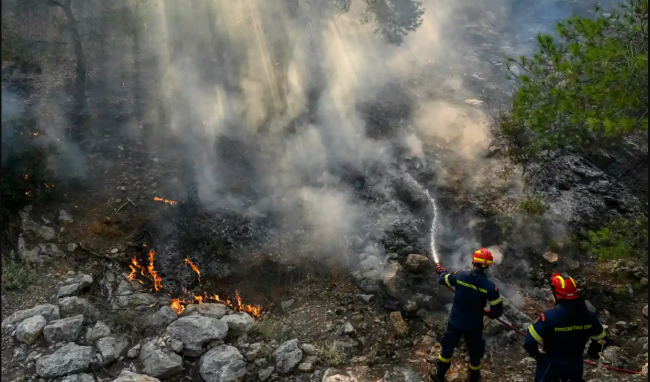Articles Menu

The world is shifting towards a superheated climate not seen in the past 1m years, prior to human existence, because “we are damned fools” for not acting upon warnings over the climate crisis, according to James Hansen, the US scientist who alerted the world to the greenhouse effect in the 1980s.
Hansen, whose testimony to the US Senate in 1988 is cited as the first high-profile revelation of global heating, warned in a statement with two other scientists that the world was moving towards a “new climate frontier” with temperatures higher than at any point over the past million years, bringing impacts such as stronger storms, heatwaves and droughts.
The world has already warmed by about 1.2C since mass industrialization, causing a 20% chance of having the sort of extreme summer temperatures currently seen in many parts of the northern hemisphere, up from a 1% chance 50 years ago, Hansen said.
“There’s a lot more in the pipeline, unless we reduce the greenhouse gas amounts,” Hansen, who is 82, told the Guardian. “These superstorms are a taste of the storms of my grandchildren. We are headed wittingly into the new reality – we knew it was coming.”
Hansen was a Nasa climate scientist when he warned lawmakers of growing global heating and has since taken part in protests alongside activists to decry the lack of action to reduce planet-heating emissions in the decades since.

“It means we are damned fools,” Hansen said of humanity’s ponderous response to the climate crisis. “We have to taste it to believe it.”
This year looks likely to be the hottest ever recorded globally, with the summer already seeing the hottest June and, possibly, hottest week ever reliably measured. Conversely, 2023 may in time be considered an average or even mild year, as temperatures continue to climb. “Things will get worse before they get better,” Hansen said.
“This does not mean that the extreme heat at a particular place this year will recur and grow each year. Weather fluctuations move things around. But the global average temperature will go up and the climate dice will be more and more loaded, including more extreme events.”
Hansen has argued in a new research paper, which has yet to be peer-reviewed, that the rate of global heating is accelerating, even when natural variations, such as the current El Niño climatic event that periodically raises temperatures, are accounted for. This is due to what he said was an “unprecedented” imbalance in the amount of energy coming into the planet from the sun versus the energy reflected away from Earth.
While global temperatures are undoubtably climbing due to the burning of fossil fuels, scientists are divided over whether this rate is accelerating. “We see no evidence of what Jim is claiming,” said Michael Mann, a University of Pennsylvania climate scientist who added that the heating of the climate system had been “remarkably steady”. Others said the idea was plausible, although more data was required to be certain.
“It’s maybe premature to say the warming is accelerating, but it’s not decreasing, for sure. We still have our foot on the gas,” said Matthew Huber, an expert in paleoclimatology at Purdue University.

Scientists have estimated, through reconstructions based on evidence gathered via ice cores, tree rings and sediment deposits, that the current surge in heating has already brought global temperatures to levels not seen on Earth since about 125,000 years ago, before the last ice age.
“We quite possibly are already living in a climate that no human has lived through before and we are certainly living in a climate that no human has lived in since before the birth of agriculture,” said Bob Kopp, a climate scientist at Rutgers University.
Should global temperatures rise by a further 1C or more, which is widely predicted to happen by the end of the century barring a drastic reduction in emissions, Huber said Hansen was “broadly correct” that the world will be plunged into the sort of warmth not seen since 1-3m years ago, a period of time called the Pliocene.
“That is a radically different world,” said Huber of an epoch in which it was warm enough for beech trees to grow near the south pole and sea levels were about 20 meters higher than now, which would today drown most coastal cities.
“We are pushing temperatures up to Pliocene levels, which is outside the realm of human experience; it’s such a massive change that most things on Earth haven’t had to deal with it,” Huber said. “It’s basically an experiment on humans and ecosystems to see how they respond. Nothing is adapted to this.”
Previous shifts in the climate, spurred by greenhouse gases or changes in the Earth’s orbit, have caused changes to unfold over thousands of years. But as heatwaves strafe populations unused to extreme temperatures, forests burn and marine life struggles to cope with soaring ocean heat, the current upward spike is occurring at a pace not seen since the extinction of the dinosaurs 65m years ago.
“It’s not just the magnitude of change, it’s the rate of change that’s an issue,” said Ellen Thomas, a Yale University scientist who studies climate over geologic timescales. “We have highways and railroads that are set in place, our infrastructure can’t move. Almost all my colleagues have said that, in hindsight, we have underestimated the consequences. Things are moving faster than we thought, which is not good.”
This summer’s searing heat has fully revealed to the world a message that Hansen attempted to deliver 35 years ago and scientists have strived to convey since, according to Huber. “We have been staring this in the face as scientists for decades, but now the world is going through that same process, which is like the five stages of grief,” he said. “It’s painful to watch people go through it.
“But we can’t simply give up because the situation is dire,” Huber added. “We need to say ‘Here is where we need to invest and make changes and innovate’ and not give up. We can’t just write off billions of people.”
[Top photo: Firefighters try to control a wildfire in New Peramos, near Athens, Greece. Photograph: Louisa Gouliamaki/AFP/Getty Images]